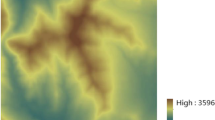Abstract
In order to display 3D terrain map effectively , detections of features on maps are very important. In this paper, we discuss a method for detection of ridges. It is known in the previous work that the steepest ascent method is effective for a ridge detection on terrain map represented by rectangular dissections. We will introduce the steepest ascent method in triangular dissections generated by homogeneous rectangular dissections.
Access this chapter
Tax calculation will be finalised at checkout
Purchases are for personal use only
Similar content being viewed by others
References
Cousty, J., Bertrand, G., Najman, L., Couprie, M.: Watershed cuts: minimum spanning forests and the drop of water principle. Proc. IEEE Trans. PAMI 31(8), 1362–1374 (2009)
Koka, S., Anada, K., Nomaki, K., Sugita, K., Tsuchida, K., Yaku, T.: Ridge detection with the steepest ascent method. procedia Comput. Sci. 4, 216–221 (2011)
Kikuchi, T., Anada, K., Koka, S., Miyadera, Y., Yaku, T.: A data structure for triangular dissection of multi-resolution images. In: Proceedings of the 15th ACIS International Conference on Software Engineering, Artificial Intelligence, Networking and Parallel/Distributed Computing (SNDP 2014), pp. 490-495 (2014)
Koka, S., Anada, K., Nakayama, Y., Sugita, K., Yaku, T., Yokoyama, R.: A comparison of ridge detection methods for DEM data. In: Proceedings of the 13th ACIS International Conference on Software Engineering, Artificial Intelligence, Networking and Parallel/Distributed Computing (SNDP 2012), pp. 513-517 (2012)
Yokoyama, R., Kureha, A., Motohashi, T., Ogasawara, H., Yaku, T., Yoshino, D.: Geographical concept recognition with the octgrid method for learning geography and geology. Proc. IEEE ICALT 2007, 470–471 (2007)
Acknowledgments
We would like to thank Prof. Kimio Sugita of Tokai University and Prof. Kensei Tsuchida of Toyo University for their valuable suggestions.
Author information
Authors and Affiliations
Corresponding author
Editor information
Editors and Affiliations
Rights and permissions
Copyright information
© 2016 Springer International Publishing Switzerland
About this paper
Cite this paper
Anada, K., Kikuchi, T., Koka, S., Miyadera, Y., Yaku, T. (2016). A Method of Ridge Detection in Triangular Dissections Generated by Homogeneous Rectangular Dissections. In: Lee, R. (eds) Software Engineering, Artificial Intelligence, Networking and Parallel/Distributed Computing 2015. Studies in Computational Intelligence, vol 612. Springer, Cham. https://doi.org/10.1007/978-3-319-23509-7_10
Download citation
DOI: https://doi.org/10.1007/978-3-319-23509-7_10
Published:
Publisher Name: Springer, Cham
Print ISBN: 978-3-319-23508-0
Online ISBN: 978-3-319-23509-7
eBook Packages: EngineeringEngineering (R0)




